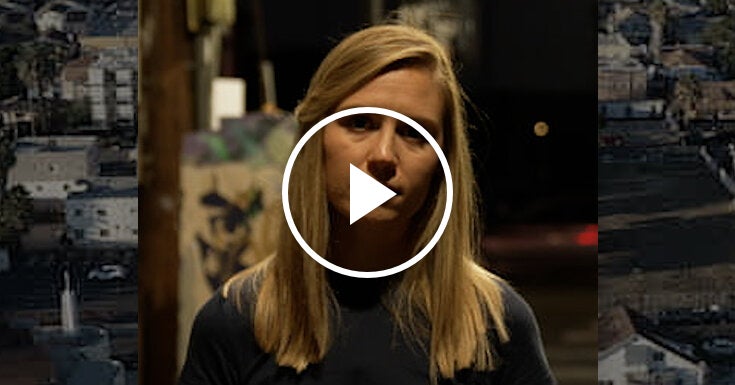EMILY: [00:00:00] I’m at the edge of what’s known in LA as the Blade. EMILY: It’s one of the most notorious sex trafficking… corridors in the United States. [00:00:07][6.8] It’s a three and a half mile long stretch of figure A corridor. There are churches and schools, but there are also girls as young as 11 forced to solicit customers for sex. EMILY: late at night, you’ll start to see lots of fancy cars pull up. Girls are coming out of vans, out of cars.//they’re trying to meet the quotas of their traffickers. Some of the busiest institutions on The Blade are motels where the girls are being held…there are smoke shops that are really tailoring to the trade. EMILY: I’ve been following this issue for two and a half years. I’ve spoken to the mayor, the city attorney, law enforcement. Everyone seems to know this issue is going on. So why is it so hard to get to the root of the problem? (The LAPD’s 77th division) covers the northern half of the Blade… This vice squad has identified hundreds of suspected traffickers on the blade. But even when officers are confident that someone is a child sex trafficker, they need to collect enormous amounts of evidence in order to arrest them and then prosecute them in court. They often rely on rescuing these juvenile girls, in part to help them escape, but also to gather intelligence about their traffickers. OFFICER LEE: Today we’ll be doing a juvenile C Sec minor rescue operation starting at 1900. EMILY: [00:00:54] The plan for tonight is to go out with undercover operators who are going to try to pose as customers and pick these girls up OFFICER LEE: Anyone that is youthful in appearance and is confirmed to be a streetwalking prostitute will be detained pending a human trafficking investigation and brought back here to 77 station…. EMILY: [00:01:51] On this particular street in Los Angeles, prostitution itself has always been a problem. But there have been a few factors in recent years that have led to the uptick in trafficking of juveniles. [00:02:02][11.1] EMILY: [00:02:02] One of the reasons for that was in 2020, when the pandemic occurred. Lots of children were out of school, they were spending more time online on social media, which is where a lot of sex traffickers recruit children. [00:02:14][12.5] Gangs began to recognize these girls as a major source of revenue on the Blade. OFFICER Navarro: after 2020, you see such an influx of women. It’s a lot of money out here. These gang members noticed that. Do you sell one rack of cocaine, one baggie of meth at a time? Female can be resold again and again, multiple times. If you have one girl, you can easily make $1,200 a day easily. And the females are very, very reluctant to turn them in, sometimes out of fear, sometimes because they’ve been manipulated to think that, oh, this is my boyfriend, or he actually cares for me. Then unfortunately, a lot of these guys want younger looking females. But as this crisis has grown, the officers say that the resources to fight it have not kept up. LAPD’s Central Human Trafficking Unit has been disbanded, which means that vice units like the one at 77th Street Division are having to carve out the time for this on their own. This sergeant asked us not to show his face because he’s working undercover. OFFICER GARCIA: [01:26:13]one of the biggest challenges we have is/how many officers it takes to just investigate one female, all the moving parts, it’s time consuming so it’s real overwhelming Five years ago, it was illegal to loiter for the purpose of prostitution. So officers were able to pull up to a corner and apprehend a whole group of girls hoping to recover minors among them. But a 2022 bill repealed that law out of concern that it was leading to racial profiling of black, brown and trans women based on how they dressed. Now officers have to pursue girls one at a time. That requires methodical undercover operations. EMILY: [00:01:05] One of the undercover officers has identified a juvenile on social media who’s planning to meet up with him for sex. They’re hoping to arrange a pickup for that girl. [00:01:14][8.6] OFFICER GARCIA: [00:02:32] The agreement was to meet at 10 o’clock at this location. The goal is to have somebody watching every p oint of the intersection when she arrives. [00:02:54][22.9 OFFICER Navarro: [00:03:10] We have a possible juvenile detained. [00:03:17][6.8] OFFICER Navarro: [00:03:17] She told him how she’s gonna be dressed and sure enough you see her walking up, matching the description, It turns out she’s fourteen. [00:03:26][9.8]// The girl is temporarily handcuffed, but she’s not being arrested. This is what the squad calls a juvie rescue operation. OFFICER Navarro: they’re gonna call children’s services and she’ll be taken to get medically screened and then placement for her. And they’re gonna make contact with the parents. I don’t know if they’ll return her to them. //She’s very young. Hopefully we caught her soon enough the reality is that three out of four girls who are rescued from the blade tend to go back to their trafficker. Sound up: Vice squad EMILY: [00:04:34] When juvenile girls are brought into the station, they’re not booked for the crime of prostitution. They’re brought into a completely different area that officers and volunteers have tried to make very comfortable. The girl was successfully apprehended. So law enforcement considers this a successful operation. But the reality is that three out of four girls who are rescued from the blade tend to go back to their trafficker. Tonight operation lasted almost seven hours, but they weren’t able to catch and arrest any traffickers tonight.

